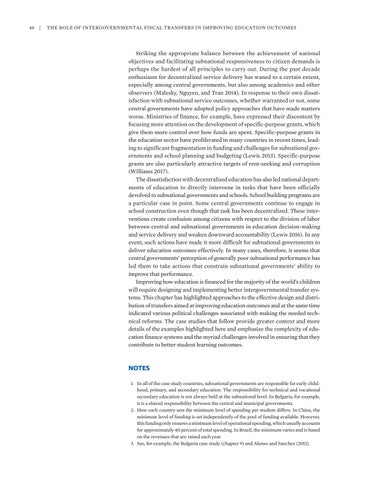46 | The Role of Intergovernmental Fiscal Transfers in Improving Education Outcomes
Striking the appropriate balance between the achievement of national objectives and facilitating subnational responsiveness to citizen demands is perhaps the hardest of all principles to carry out. During the past decade enthusiasm for decentralized service delivery has waned to a certain extent, especially among central governments, but also among academics and other observers (Malesky, Nguyen, and Tran 2014). In response to their own dissatisfaction with subnational service outcomes, whether warranted or not, some central governments have adopted policy approaches that have made matters worse. Ministries of finance, for example, have expressed their discontent by focusing more attention on the development of specific-purpose grants, which give them more control over how funds are spent. Specific-purpose grants in the education sector have proliferated in many countries in recent times, leading to significant fragmentation in funding and challenges for subnational governments and school planning and budgeting (Lewis 2013). Specific-purpose grants are also particularly attractive targets of rent-seeking and corruption (Williams 2017). The dissatisfaction with decentralized education has also led national departments of education to directly intervene in tasks that have been officially devolved to subnational governments and schools. School building programs are a particular case in point. Some central governments continue to engage in school construction even though that task has been decentralized. These interventions create confusion among citizens with respect to the division of labor between central and subnational governments in education decision-making and service delivery and weaken downward accountability (Lewis 2016). In any event, such actions have made it more difficult for subnational governments to deliver education outcomes effectively. In many cases, therefore, it seems that central governments’ perception of generally poor subnational performance has led them to take actions that constrain subnational governments’ ability to improve that performance. Improving how education is financed for the majority of the world’s children will require designing and implementing better intergovernmental transfer systems. This chapter has highlighted approaches to the effective design and distribution of transfers aimed at improving education outcomes and at the same time indicated various political challenges associated with making the needed technical reforms. The case studies that follow provide greater context and more details of the examples highlighted here and emphasize the complexity of education finance systems and the myriad challenges involved in ensuring that they contribute to better student learning outcomes.
NOTES 1. In all of the case study countries, subnational governments are responsible for early childhood, primary, and secondary education. The responsibility for technical and vocational secondary education is not always held at the subnational level. In Bulgaria, for example, it is a shared responsibility between the central and municipal governments. 2. How each country sets the minimum level of spending per student differs. In China, the minimum level of funding is set independently of the pool of funding available. However, this funding only ensures a minimum level of operational spending, which usually accounts for approximately 40 percent of total spending. In Brazil, the minimum varies and is based on the revenues that are raised each year. 3. See, for example, the Bulgaria case study (chapter 9) and Alonso and Sanchez (2011).






